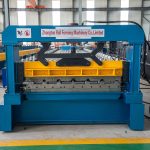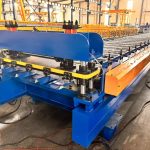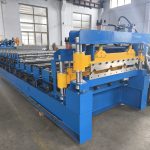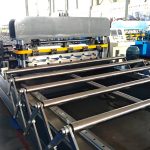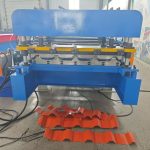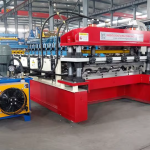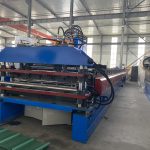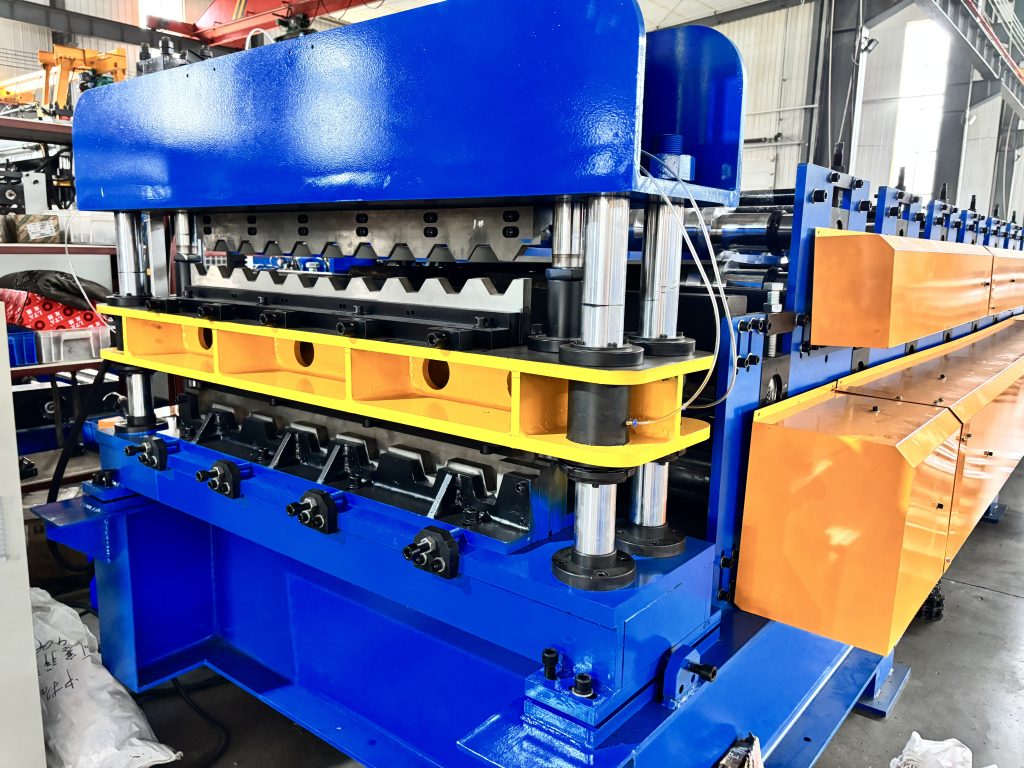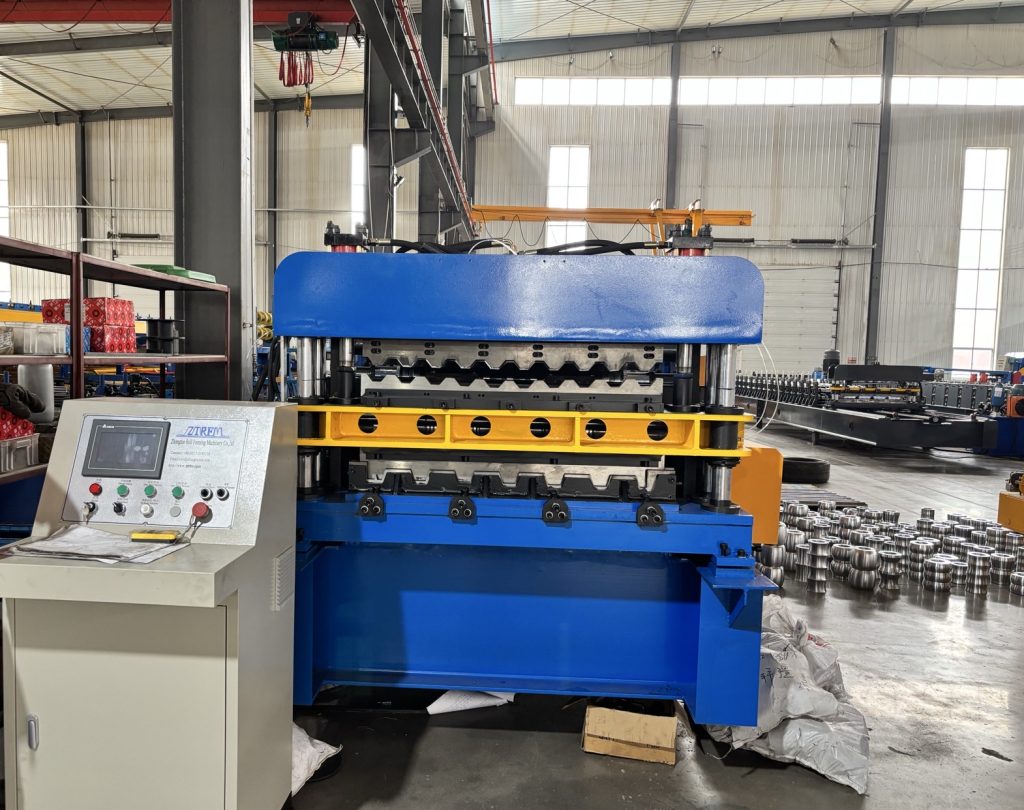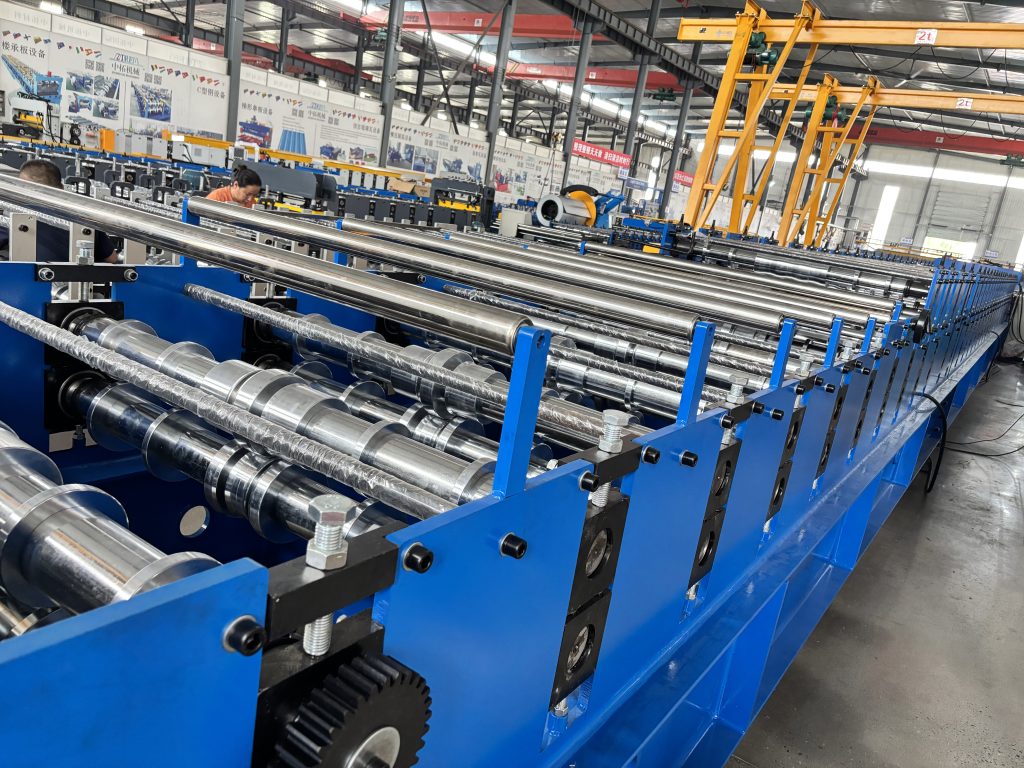In the field of modern construction, the quality and performance of roofing materials play a key role in the overall safety, aesthetics, and durability of buildings. Double-layer roofing tiles are increasingly favored by the market due to their excellent thermal insulation, thermal insulation, waterproofing and load-bearing performance. As the core equipment for the production of such high-quality roofing tiles, double-layer roofing tile equipment is constantly promoting the technological innovation and development of the building roofing material production industry.
Product Attributes :
|
1.Formed Material
|
PPGI,GI,AI,GL
|
Thickness:0.3-0.8mm Width:1000mm/1250mm(As per profile drawing)
|
||
|
2.Decoiler
|
Hydraulic automatic decoiler
|
Manual decoiler(will give you as free)
|
||
|
3.Main body
|
Roller station
|
16+18 rows(As your requirement)
|
||
|
Diameter of shaft
|
80mm solid shaft
|
|||
|
Material of rollers
|
45# steel, hard chrome plated on the surface
|
|||
|
Machine body frame
|
350 H steel
|
|||
|
Drive
|
Chain transmission
|
|||
|
Dimension(L*W*H)
|
10500*1600*1600(customize)
|
|||
|
Weight
|
11.5T
|
|||
|
4.Cutter
|
Automatic
|
cr12mov material, no scratches, no deformation
|
||
|
5.Power
|
Motor Power
|
5.5KW
|
||
|
Hydraulic system power
|
5.5KW
|
|||
|
6.Voltage
|
380V 50Hz 3Phase
|
As your requirement
|
||
|
7.Control system
|
Electric Box
|
Customized(famous brand)
|
||
|
Language
|
English(Support multiple languages)
|
|||
|
PLC
|
Automatic production of the whole machine. Can set batch, length, quantity, etc.
|
|||
|
18.Forming Speed
|
15-20m/min
|
The speed depends on the shape of the tile and the thickness of the material.
|
||
Detailed explanation of structural composition:
1.Discharge system:
The discharge system is mainly composed of a discharge frame and an uncoiling mechanism. The discharge rack is usually made of high-strength steel, which has sufficient load-bearing capacity to stably place sheet metal coils of different sizes and weights. The uncoiler is responsible for unwinding the plate roll slowly and smoothly, and at the same time, through the tension control system, the tension of the plate during the unwinding process is accurately adjusted to prevent the plate from slacking, deviating or overstretching, and ensuring that the plate can smoothly and accurately enter the subsequent processing process.
2.Leveling device:
The leveling machine is a key equipment to ensure the flatness of the plate. It is generally composed of multiple sets of leveling rollers arranged in a staggered manner, and the roller material is mostly high-quality alloy steel, and has been precision machining and surface hardening to improve its wear resistance and leveling accuracy. By adjusting the clearance and pressure between the leveling rollers, effective leveling operations can be performed for plates of different thicknesses and materials. Some high-end leveling devices are also equipped with automatic detection and adjustment systems, which can monitor the flatness of the plate in real time and automatically adjust the leveling parameters according to the feedback data to further improve the leveling effect.
3.Double-layer forming host:
This is the core component of double-layer roofing tile equipment, and its structural design and mold accuracy directly determine the molding quality of roofing tiles. The main frame is made of high-strength steel plate welded as a whole, which has good rigidity and stability, and can withstand the huge pressure and impact generated during the forming process. The upper and lower layers of forming molds are installed on the sliding guide rails inside the main machine, which can be quickly replaced and adjusted according to the needs of producing different specifications of roofing tiles. The mold is made of high-quality mold steel, which has undergone precision machining, heat treatment and surface coating treatment, which has high hardness, high strength, good wear resistance and release performance, which can ensure the long-term stable production of high-precision and high-quality double-layer roofing tiles.
4.Control system:
The modern double-layer roofing tile equipment is equipped with an advanced automation control system, with a programmable logic controller (PLC) as the core, combined with a human-machine interface (HMI) to achieve comprehensive monitoring and precise control of equipment operation. Operators only need to input production parameters such as specifications, production speed, and quantity of roofing tiles on the HMI, and the PLC will automatically control the actions of each component according to the preset program to realize the automatic operation of the equipment. The control system also has functions such as fault diagnosis, alarm prompts, production data statistics and analysis. It can monitor the operating status of each component of the equipment in real time, motor current, hydraulic system pressure and other parameters, and once an abnormal situation is found, it immediately sends out an alarm signal and accurately displays the location and cause of the fault, which is convenient for maintenance personnel to quickly investigate and repair. At the same time, the control system can also record and analyze the data generated during the production process, providing strong data support for enterprises to optimize production processes, improve production efficiency and product quality.
Wide coverage of application fields:
1.Industrial construction field:
In various industrial plants, warehouses, logistics centers and other industrial buildings, the double-layer roofing tiles produced by double-layer roofing tile equipment have been widely used. Industrial buildings usually have high requirements for the bearing capacity, waterproof performance and thermal insulation performance of the roof. Through the composite of double-layer metal plate structure and intermediate insulation core material, double-layer roofing tiles can effectively improve the strength and bearing capacity of the roof, and resist the erosion of bad weather and industrial environments. At the same time, good thermal insulation properties help reduce energy consumption inside industrial buildings and provide a stable and comfortable indoor environment for industrial production. For example, in some large machinery manufacturing plants, electronic equipment production workshops, etc., double-layer roof tiles not only meet the needs of building structure and function, but also enhance the overall image of industrial buildings because of their beautiful appearance.
2.Civil construction:
In civil residences, villas, apartments and other buildings, double-layer roof tiles are also increasingly favored. For residential buildings, the waterproofing, thermal insulation and aesthetics of the roof are the focus of owners. The roofing tiles produced by double-layer roofing tile equipment have excellent waterproof performance, which can effectively prevent rainwater leakage and protect the internal structure and decoration of the house. Its thermal insulation performance can reduce indoor and outdoor heat transfer, reduce the energy consumption of air conditioning and heating equipment, and create a comfortable living environment for residents. In addition, double-layer roof tiles come in a variety of colors and shapes, which can meet the individual needs of different architectural styles and owners, adding a unique charm to residential buildings. In some high-end residential communities and villa projects, double-layer roof tiles are particularly widely used and have become an important element to improve the quality and value of buildings.
3.In the field of public buildings:
In public buildings such as gymnasiums, exhibition halls, terminals, schools, and hospitals, double-layer roof tiles also play an important role. Public buildings usually have large space spans and high building heights, and have extremely high requirements for the safety, durability and functionality of roofing materials. The products produced by double-layer roof tile equipment can well meet these needs of public buildings with their high strength, light weight, and good thermal insulation, thermal insulation, sound insulation and other performances. For example, in large stadiums and exhibition halls, double-layer roof tiles can not only provide reliable roof covering, but also reduce the load on indoor air conditioning systems and save energy through their good thermal insulation performance. In buildings with high environmental comfort requirements, such as schools and hospitals, the sound insulation performance of double-layer roof tiles can effectively reduce external noise interference and create a quiet and comfortable space environment for teachers, students and patients.
The advantages and characteristics are significantly prominent:
1.Efficient production and increased production capacity:
The double-layer roofing tile equipment adopts an automatic control system and a continuous production process, from raw material feeding, leveling, forming, compounding to cutting, the entire production process can achieve rapid and continuous operation, greatly improving production efficiency. Compared with traditional single-layer roofing tile production equipment, double-layer roofing tile equipment can produce a larger number of roofing tiles per unit time to meet the rapid supply demand for roofing materials for large-scale construction projects. The production speed of some advanced double-layer roofing tile equipment can reach tens of meters per minute, which greatly improves the production capacity and market competitiveness of enterprises.
2.Excellent product quality and performance:
Through precise mold design and advanced molding technology, the equipment can ensure that the double-layer roofing tiles produced have high-precision dimensions, good shape consistency and smooth surface quality. The composite of double-layer structure and insulation core material gives roof tiles excellent thermal insulation performance, waterproof performance, load-bearing capacity and durability. After testing, the insulation performance of double-layer roofing tiles can be improved several times compared with single-layer roofing tiles, and the waterproof performance has reached the industry-leading level, which can effectively resist the test of various adverse weather conditions. Its bearing capacity can also meet the design requirements of different building structures, providing reliable roof protection for buildings.
3.High material utilization and reduced costs:
During the design and production process, double-layer roofing tile equipment minimizes the waste of raw materials by optimizing the molding process and mold structure. The equipment can accurately control the amount of raw materials used according to the needs of different specifications of roof tiles, so that the material utilization rate is significantly improved. Compared with traditional production methods, the use of double-layer roofing tile equipment to produce roofing tiles can save a lot of raw material costs. At the same time, due to the high production efficiency and good product quality of the equipment, the defective product rate and later maintenance costs are reduced, which further reduces the comprehensive production cost of the enterprise and improves economic benefits.
4.Product diversification to meet individual needs:
By simply replacing part of the mold and adjusting equipment parameters, the double-layer roofing tile equipment can produce a variety of double-layer roofing tiles of different specifications, models, colors and shapes to meet the diverse needs of the market. Whether it is common trapezoidal and corrugated roofing tiles, or roofing tiles with special shape and functional requirements, the equipment can easily cope with it. This diversified production capacity of products enables enterprises to better adapt to market changes, quickly respond to customer orders, provide customers with personalized roofing solutions, and enhance their competitiveness in the market.
5.Strong equipment stability and convenient maintenance:
The overall structure of the double-layer roof tile equipment is made of high-strength steel, and the key components have undergone strict quality testing and debugging, which has good stability and reliability. During long-term operation, the equipment can maintain a stable working state, reducing equipment failure and downtime. At the same time, the design of the equipment fully considers the convenience of maintenance, the layout of each component is reasonable, easy to disassemble and install, and the daily maintenance and maintenance work is simple and easy. The equipment is also equipped with a complete fault diagnosis system, which can detect and solve problems during equipment operation in a timely manner, reduce equipment maintenance costs, and extend the service life of equipment.


